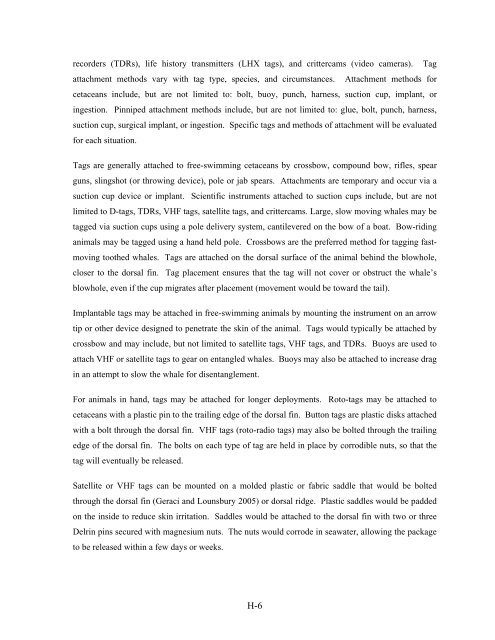Volume III, Appendices EM - National Marine Fisheries Service ...
Volume III, Appendices EM - National Marine Fisheries Service ...
Volume III, Appendices EM - National Marine Fisheries Service ...
Create successful ePaper yourself
Turn your PDF publications into a flip-book with our unique Google optimized e-Paper software.
ecorders (TDRs), life history transmitters (LHX tags), and crittercams (video cameras). Tag<br />
attachment methods vary with tag type, species, and circumstances. Attachment methods for<br />
cetaceans include, but are not limited to: bolt, buoy, punch, harness, suction cup, implant, or<br />
ingestion. Pinniped attachment methods include, but are not limited to: glue, bolt, punch, harness,<br />
suction cup, surgical implant, or ingestion. Specific tags and methods of attachment will be evaluated<br />
for each situation.<br />
Tags are generally attached to free-swimming cetaceans by crossbow, compound bow, rifles, spear<br />
guns, slingshot (or throwing device), pole or jab spears. Attachments are temporary and occur via a<br />
suction cup device or implant. Scientific instruments attached to suction cups include, but are not<br />
limited to D-tags, TDRs, VHF tags, satellite tags, and crittercams. Large, slow moving whales may be<br />
tagged via suction cups using a pole delivery system, cantilevered on the bow of a boat. Bow-riding<br />
animals may be tagged using a hand held pole. Crossbows are the preferred method for tagging fastmoving<br />
toothed whales. Tags are attached on the dorsal surface of the animal behind the blowhole,<br />
closer to the dorsal fin. Tag placement ensures that the tag will not cover or obstruct the whale’s<br />
blowhole, even if the cup migrates after placement (movement would be toward the tail).<br />
Implantable tags may be attached in free-swimming animals by mounting the instrument on an arrow<br />
tip or other device designed to penetrate the skin of the animal. Tags would typically be attached by<br />
crossbow and may include, but not limited to satellite tags, VHF tags, and TDRs. Buoys are used to<br />
attach VHF or satellite tags to gear on entangled whales. Buoys may also be attached to increase drag<br />
in an attempt to slow the whale for disentanglement.<br />
For animals in hand, tags may be attached for longer deployments. Roto-tags may be attached to<br />
cetaceans with a plastic pin to the trailing edge of the dorsal fin. Button tags are plastic disks attached<br />
with a bolt through the dorsal fin. VHF tags (roto-radio tags) may also be bolted through the trailing<br />
edge of the dorsal fin. The bolts on each type of tag are held in place by corrodible nuts, so that the<br />
tag will eventually be released.<br />
Satellite or VHF tags can be mounted on a molded plastic or fabric saddle that would be bolted<br />
through the dorsal fin (Geraci and Lounsbury 2005) or dorsal ridge. Plastic saddles would be padded<br />
on the inside to reduce skin irritation. Saddles would be attached to the dorsal fin with two or three<br />
Delrin pins secured with magnesium nuts. The nuts would corrode in seawater, allowing the package<br />
to be released within a few days or weeks.<br />
H-6
















